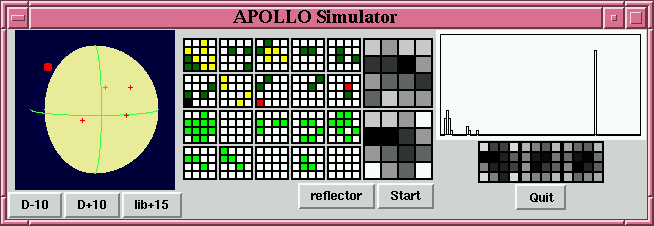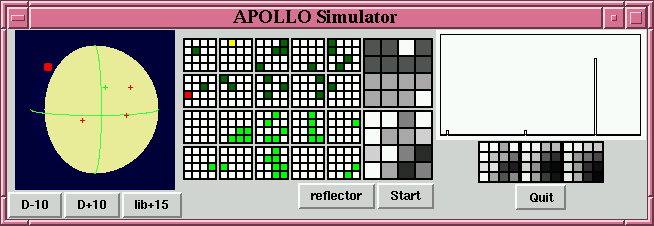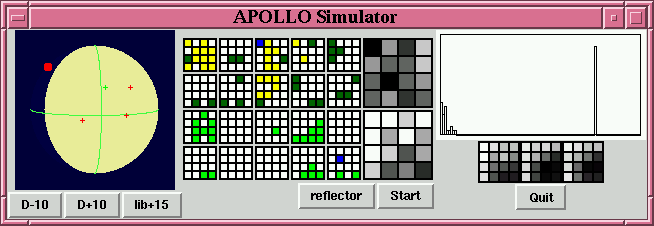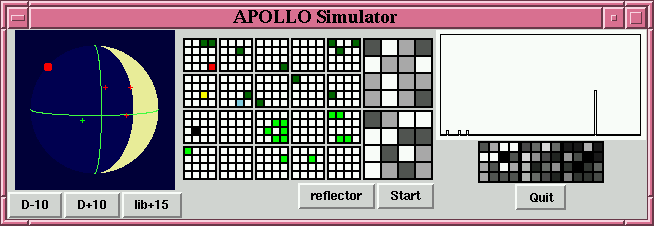Apollo 15, no offset, bright moon, 1 arcsec seeing

The APOLLO Simulator
To understand more fully what the recorded return from APOLLO will look like, I made a simulator that tries to realistically represent the performance of APOLLO in both signal and background characteristics.
The simulator acounts for instrument and observing conditions, generally biased toward making life harder. The throughput includes effects of speckle interference, optical losses, diffraction, etc. The background realistically treats air backscatter through the entire beam path, stray light from the laser fire, lunar and daylight sources, earthshine, laser return from the lunar terrain, dark noise, etc.
The following screenshots show several sets of conditions, the important commonalities described in the next paragraph.
Each panel shows the phase of the moon, the retroreflector target (green cross), and two sets of 10 grids. Each grid represents the APD array report for a single laser shot, spanning 1.5 arcseconds on a side. At 20 shots per second, each set of ten covers half a second. The top set of ten corresponds to the "calibration" photons, returning from the corner-cube in the telescope. The bottom set of ten shows the lunar returns. Photon type is color-coded, as explained below. To the right of each set is a sum of all the returns in that half-second, so that the spatial dependence can be judged. Over to the right are three summed boxes representing 1 second, 5 seconds, and 10 seconds of integration. These can be used to understand the pointing of the telescope. The histogram at upper right has time on the horizontal axis, and shows the return strength of the calibration during the half-second interval. Background photons from optics, air-path, and scattering are also visible.

Immediately obvious is that we get a lot of lunar range photons: 38 in 0.5 seconds for an average of 3.8 per pulse. The return rate is highly variable on a shot-to shot basis due to speckle interference in the far-field laser pattern. One also sees that we are well centered on the target (especially visible in 10-second integration). Despite a bright moon, there are no lunar background photons! That's mostly due to the extremely small pixel size. In the calibration frames, we get about 2 corner-cube photons per pulse, with the most significant background coming from laser scatter within the enclosure (yellow). These are well differentiated temporally, though.

Now we offset by 0.5 arcsec, and see clearly even on short (1 sec) timescales that the returns are clustered to lower right. The average is knocked down to 2.7 photons per pulse on account of decentering. Again, no lunar background.

Same offset as before, with worse seeing. The offset is still plainly visible. Finally we have a lunar background photon (blue: both in the calibration and in the lunar set).

How about a tougher target: Apollo 11 with 1.5 arcsec seeing. Clearly harder, but still getting more than 1 photon per pulse on average, and dozens per second--plenty good enough to stay on top of the return. It's hard to tell how well centered the return is, but after all, the seeing is the same as the field of view. An offset would still stand out.
For the upper set of ten panels (the calibration), the following color codes are used:
For the lunar photons, the following colors are used:
The above simulations shared the following assumptions about the instrument performance and observing conditions: